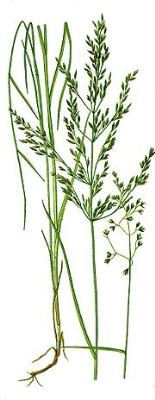
Poa nemoralis
Encyclopedia
Poa nemoralis is a perennial plant
in the Poaceae
family. The late-growing grass is fairly nutritious for livestock, which feed on it in the autumn.
It is often found in forests and grows up to half a metre tall. It is generally distributed in Britain
in dry woods, thickets and shady hedge banks on well drained soils. It is an introduced species
in North America.
It forms loose tufts, and is of a more delicate, slender appearance than other meadow grasses.
It is slightly creeping. The leaves are narrow, tapering to a point. The ligules are short (0.5 mm).
The stem is slender, 30–60 cm high. The panicle
is slender, loose and branched.
The spikelets are few and egg shaped. They have one to five flowers. It is in flower from June to August.
Because of the characteristic lamina, similar to a stretched out arm, it is sometimes called "Wegweisergras" (signpost grass) in Germany.
Plant
Plants are living organisms belonging to the kingdom Plantae. Precise definitions of the kingdom vary, but as the term is used here, plants include familiar organisms such as trees, flowers, herbs, bushes, grasses, vines, ferns, mosses, and green algae. The group is also called green plants or...
in the Poaceae
Poaceae
The Poaceae is a large and nearly ubiquitous family of flowering plants. Members of this family are commonly called grasses, although the term "grass" is also applied to plants that are not in the Poaceae lineage, including the rushes and sedges...
family. The late-growing grass is fairly nutritious for livestock, which feed on it in the autumn.
It is often found in forests and grows up to half a metre tall. It is generally distributed in Britain
United Kingdom
The United Kingdom of Great Britain and Northern IrelandIn the United Kingdom and Dependencies, other languages have been officially recognised as legitimate autochthonous languages under the European Charter for Regional or Minority Languages...
in dry woods, thickets and shady hedge banks on well drained soils. It is an introduced species
Introduced species
An introduced species — or neozoon, alien, exotic, non-indigenous, or non-native species, or simply an introduction, is a species living outside its indigenous or native distributional range, and has arrived in an ecosystem or plant community by human activity, either deliberate or accidental...
in North America.
It forms loose tufts, and is of a more delicate, slender appearance than other meadow grasses.
It is slightly creeping. The leaves are narrow, tapering to a point. The ligules are short (0.5 mm).
The stem is slender, 30–60 cm high. The panicle
Panicle
A panicle is a compound raceme, a loose, much-branched indeterminate inflorescence with pedicellate flowers attached along the secondary branches; in other words, a branched cluster of flowers in which the branches are racemes....
is slender, loose and branched.
The spikelets are few and egg shaped. They have one to five flowers. It is in flower from June to August.
Because of the characteristic lamina, similar to a stretched out arm, it is sometimes called "Wegweisergras" (signpost grass) in Germany.

